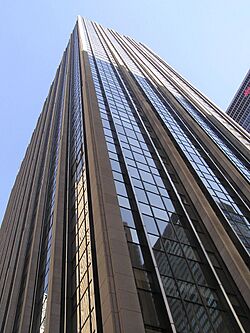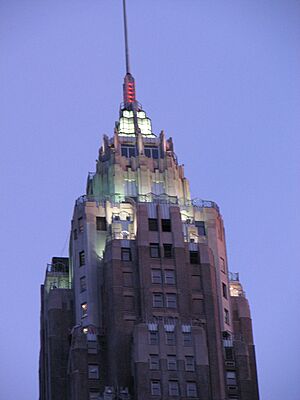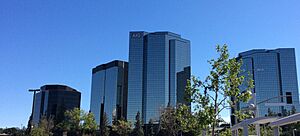American International Group facts for kids
 |
|

AIG headquarters, 1271 Avenue of the Americas, New York
|
|
| Public | |
| Traded as | |
| Industry | Financial services |
| Founded | December 19, 1919 in Shanghai, China |
| Founder | Cornelius Vander Starr |
| Headquarters | 1271 Avenue of the Americas,
,
U.S.
|
|
Area served
|
Worldwide |
|
Key people
|
Peter Zaffino (chairman and CEO) |
| Products |
|
| Revenue | |
|
Operating income
|
|
| Total assets | |
| Total equity | |
|
Number of employees
|
c. 22,000 (2024) |
| Subsidiaries | TATA AIG |
American International Group, Inc. (AIG) is a large American company that works in finance and insurance. It operates in more than 80 countries around the world. In 2023, AIG had about 25,200 employees.
The company has three main parts: general insurance, life & retirement, and a special technology-focused business. General insurance covers things like car, home, and travel insurance. Life & retirement helps people save for their future and retirement. AIG is also a main sponsor of the AIG Women's Open golf tournament.
AIG's main office is in New York City. The company also has offices in many other countries. AIG works with many of the world's biggest companies. In 2018, it was ranked 60th on the Fortune 500 list of top companies.
During the 2008 financial crisis, the U.S. government helped AIG with $180 billion. This was to prevent bigger problems in the financial system. AIG paid back $205 billion to the government by 2012.
Contents
AIG's Journey: A Look at Its History


How AIG Started (1919–1959)
AIG began on December 19, 1919, in Shanghai, China. An American named Cornelius Vander Starr started a company called American Asiatic Underwriters (AAU). It offered general insurance. The business grew quickly. Two years later, Starr added life insurance.
By the late 1920s, AAU had offices across China and Southeast Asia. In 1926, Starr opened his first U.S. office in New York City. He also expanded into Latin America. In 1939, Starr moved his main office from Shanghai to New York City.
After World War II, AIG expanded into Japan and Germany. They provided insurance for American military members. By the late 1950s, Starr's company had offices in over 75 countries.
Growing and Changing (1959–2000)
In 1960, Hank Greenberg joined the company. He helped develop its international accident and health insurance business. In 1967, American International Group, Inc. (AIG) was created. It brought together most of Starr's insurance businesses. Greenberg became Starr's successor in 1968. The company became public in 1969.
The 1970s brought challenges, but AIG kept growing. They offered new types of insurance for industries like energy and shipping. In the 1980s, AIG continued to expand worldwide. They offered specialized products like pollution liability insurance. In 1984, AIG shares were listed on the New York Stock Exchange.
In the 1990s, AIG found new ways to earn money. They bought International Lease Finance Corporation (ILFC), which leased airplanes to airlines. In 1992, AIG was the first foreign company to get an insurance license in China in over 40 years.
Challenges and Changes (2000–2012)

The early 2000s were a time of growth for AIG. They bought American General Corporation, a big life insurance provider. AIG also entered new markets like India.
Financial Issues
In 2005, AIG faced investigations about how it reported its finances. The company had to correct its financial statements from previous years. This led to a large fine for AIG.
AIG also got involved in insuring against risks related to mortgages. They insured many financial products without enough protection. When the housing market faced problems in 2007–2008, AIG had to pay out many claims. This caused a big financial crisis for the company.
Government Help (2008)
In late 2008, the U.S. government stepped in to help AIG. Many believed that if AIG failed, it would harm other major financial companies. The government provided AIG with $180 billion in aid. In return, the government took a large ownership stake in the company.
Experts later said AIG's problems grew because it sold many credit default swaps. These were like insurance policies on other investments. AIG sold them without setting aside enough money to cover potential losses. This was seen as a major problem in how the company managed its risks.
The government's help was the largest bailout of a private company in U.S. history at that time. AIG began selling some of its businesses to pay back the government loans. By 2012, AIG had paid back $205 billion to the U.S. government.
AIG Today (2012–Present)
In 2012, the U.S. government began selling its shares in AIG. By December 2012, the government had sold all its AIG stock. The government made a profit of over $22 billion from helping AIG.
In 2013, AIG launched an advertising campaign called "Thank You America." In these ads, AIG employees thanked the government for its help.
In 2015, an investor suggested that AIG should be broken up into smaller companies. AIG then sold its mortgage insurance unit in 2016. In 2017, Brian Duperreault became AIG's CEO. He planned to grow AIG and keep it as a company offering many types of insurance.
In 2018, AIG bought Validus Holdings Ltd., a reinsurance company. Reinsurance is insurance for insurance companies. AIG also bought Ellipse, a UK life insurance business.
In 2019, AIG started a program called "AIG 200." This program aimed to make the company's operations better and more modern. In 2021, Peter Zaffino became AIG's CEO.
In 2022, AIG spun off its life and retirement insurance business into a new company called Corebridge Financial. This new company became independent. In 2023, AIG continued to sell some of its smaller businesses. In March 2024, British regulators approved the sale of AIG Life Ltd's UK part to Aviva.
What AIG Does
AIG offers many types of insurance and financial services. These include:
- Property and casualty insurance (for homes, cars, and businesses)
- Life insurance
- Retirement products (to help people save for retirement)
- Mortgage insurance (which protects lenders if a borrower can't pay their mortgage)
In the U.S., AIG is one of the biggest providers of insurance for businesses.
AIG's Sponsorships
AIG has sponsored several well-known sports teams and events.
- Manchester United F.C. AIG was the main shirt sponsor for the English football club Manchester United F.C. from 2006 to 2010. During this time, the club won many titles.
- AIG Women's Open In 2019, AIG became the main sponsor of the Women's British Open golf tournament. The event was renamed the AIG Women's Open. AIG has increased the prize money for this tournament, making it one of the highest-paying events in women's golf. In 2023, AIG announced it would continue sponsoring the event until 2030.
AIG's Other Companies
AIG owns several other companies, also known as subsidiaries. Some of these include:
- AIG Europe S.A.
- American General Life Insurance Company
- American Home Assurance Company
- Lexington Insurance Company
- National Union Fire Insurance Company of Pittsburgh, PA
- The United States Life Insurance Company in the City of New York
- The Variable Annuity Life Insurance Company (VALIC)
- American International Group UK Ltd.
- AIG General Insurance Co. Ltd.
- Validus Reinsurance, Ltd.
Images for kids
-
AIG headquarters, 1271 Avenue of the Americas, New York
-
The North China Daily News Building in Shanghai, where AIG first started.
-
70 Pine Street was once known as the American International Building.
-
The AIG Towers in Woodland Hills, Los Angeles.
See also
 In Spanish: American International Group para niños
In Spanish: American International Group para niños







